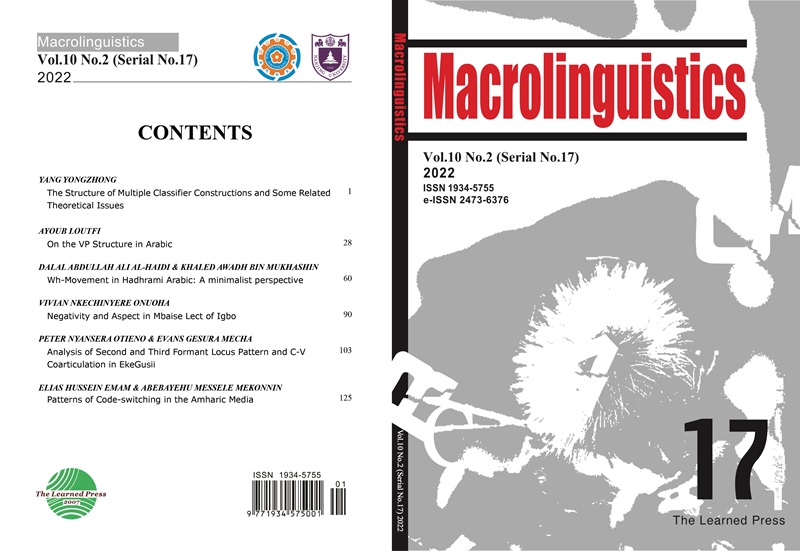Sentences with Object-oriented Adverbials and the Syntax-Semantics Interface
引用次数: 0
Abstract
SOOAs refer to the phenomenon that the state adjective in the adverbial position is semantically associated with the object. In this paper this fact will be accounted for by invoking the properties of a pre-syntactic level of semantic representation and its interplay with syntax proper. It will be argued that the object-oriented adverbial is not derived from the attributive; in effect, it is base-generated in the complement position. A model of projection of arguments that allows for this will be proposed. It will be shown that the other special properties of SOOAs follow from the way the verb’s object and complement are represented at the pre-syntactic level. In particular, it will be shown that the underlying structure must satisfy both the requirement of the syntactic system and the requirement of the semantic system. The presence of any symbol in a representation is conditional. The theta-roles of internal arguments are assigned by the predicate, which is locally constrained, whereas the theta-roles of external arguments are assigned by the maximal projection of the predicate, viz. VP. When an external argument occurs, there is an empty predicate position in the representation, for there is an asymmetry between the conceptual system and the syntactic system. Derivation involves Move-α and Generalized Transformation. Different use of derivation methods gives rise to various forms of constructions in Chinese. Similarly, different semantic orientations result from different distributions. The state adjective is base-generated in the position behind the object because its nature is to serve the function of the complement of the object. It co-occurs with the object in the embedded VP because they are closely related to each other in terms of semantics. There is no overt predicate between the object and the state adjective. The state adjective occurs in other positions, which is the result of movement. Movement falls into two types, viz. object movement and state adjective movement. Object movement is prior to state adjective movement. In order to satisfy the requirement of feature checking, the object moves to the position NP. Then the state adjective moves to the major predicate and merges with it so as to maintain its semantic association with the state adjective and to serve the function of the complement. It follows that the difference between Chinese SOOAs and English as well as German SOOAs lies in the distance of movement of state adjectives. In Chinese, there are causative markers, resultative markers, and manner markers that can license the state adjective in the landing sites and help to maintain its semantic association with the object while in English and German there are no such markers. As a consequence, the object in Chinese-type SOOAs does not move while the state adjective moves out of the embedded VP to the empty verb position where the manner marker is inserted. The major predicate moves to the same position and merges with the newly-formed syntactic object ADJ-MANN. Furthermore, Chinese-type SOOAs allow the state adjective to precede the major predicate as the manner marker can license the state adjective. In contrast, in English-type SOOAs, neither the state adjective nor the object moves. Moreover, English-type SOOAs do not allow the state adjective to come before the major predicate because there is no manner marker to license it.宾语副词句与句法语义界面
SOOA是指处于状语位置的状态形容词与宾语在语义上相关联的现象。在本文中,这一事实将通过调用句法前语义表示的性质及其与句法本体的相互作用来解释。有人认为,面向对象的状语不是从定语派生出来的;实际上,它是在补码位置生成的碱基。将提出一个考虑到这一点的论点投影模型。结果表明,SOOA的其他特殊性质源于动词宾语和补语在句法前的表达方式。特别是,它将表明底层结构必须满足句法系统的要求和语义系统的要求。表示中任何符号的存在都是有条件的。内部自变量的θ角色由谓词分配,谓词是局部约束的,而外部自变量的θ作用由谓词的最大投影分配,即VP。当外部论证发生时,表示中有一个空的谓词位置,因为概念系统和句法系统之间存在不对称。求导涉及移动-α和广义变换。派生方法的不同使用导致了汉语结构形式的多样性。同样,不同的语义取向也会产生不同的分布。状态形容词产生于宾语后面的位置,因为它的性质是服务于宾语补语的功能。它与嵌入VP中的对象共存,因为它们在语义上彼此密切相关。宾语和状态形容词之间没有明显的谓语。状态形容词出现在其他位置,这是运动的结果。运动分为两类,即宾语运动和状态形容词运动。宾语运动先于状态形容词运动。为了满足特征检测的要求,宾语移动到NP位置,状态形容词移动到主谓语并与其融合,以保持其与状态形容词的语义关联,并起补语的作用。由此可见,汉语SOOA与英语及德语SOOA的区别在于状态形容词的移动距离。在汉语中,有致使标记、结果标记和方式标记可以在着陆点许可状态形容词,并有助于保持其与宾语的语义关联,而在英语和德语中则没有这样的标记。因此,当状态形容词从嵌入的VP移到插入方式标记的空动词位置时,汉语类型SOOA中的宾语不会移动。主谓语移到同一位置,并与新形成的句法宾语ADJ-MANN融合。此外,汉语类型SOOA允许状态形容词在主谓语之前,因为方式标记可以许可状态形容词。相反,在英语类型的SOOA中,状态形容词和宾语都不动。此外,英语类型SOOA不允许状态形容词出现在主谓语之前,因为没有方式标记来许可它。
本文章由计算机程序翻译,如有差异,请以英文原文为准。
求助全文
约1分钟内获得全文
求助全文
来源期刊
自引率
0.00%
发文量
83
审稿时长
20 weeks
期刊介绍:
Macrolinguistics (ISSN 1934-5755, e-ISSN 2473-6376) is an international academic journal which is specialized in research papers of non-Indo-European linguistics. It is published biannually by The Learned Press and funded by the Double First-Class Initiative of Nanjing University. It aims at contributing to the complementarity and interaction of linguistic research worldwide.

 求助内容:
求助内容: 应助结果提醒方式:
应助结果提醒方式:


